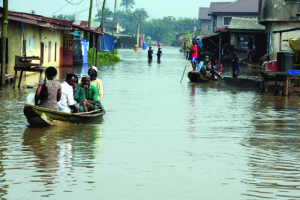A call has been made by stakeholders in the environment sector, urging the authorities to build a buffer dam in Adamawa to curtail the excess water being released from the Lagdo Dam in Cameroon.

The call is contained in a communiqué issued on Thursday, August 13, 2005 in Abuja, at the end of a daylong stakeholders’ roundtable for the management of the 2015 predicted flood. The roundtable was organised by the Federal Ministry of Environment for stakeholders.
The communiqué which was read by the Permanent Secretary of the ministry, Mrs Nana Mede, called for the completion of the dam, known as the Datsin Hausa Dam, in the next three to four years.
A couple of weeks ago, the Nigeria Hydrological Services Agency (NIHSA) in Abuja warned that 12 states might experience high flood this year. Director-General of the agency, Dr Moses Beckley, made the disclosure at the presentation of the 2015 Annual Flood Outlook.
Commenting on the highlight of the report, Beckley listed the states as Niger, Delta, Bayelsa, Rivers, Anambra, Taraba, Nasarawa, Kebbi, Sokoto, Adamawa, Kogi and Benue.
Beckley said that probable risks areas in the country had been classified into: High Risk, Medium Risk and Low Risk Flood areas. He listed River Basins of Sokoto-Rima, Niger-Benue and Anambra as those that might experience high flooding.
Beckley also said that local areas in Shinkafi, Biase, Chikum, Munya, Bukuru, Bonny, Etiosa among others might experience moderate flooding. He added that Bayelsa, Rivers, Delta and Lagos are expected to experience coastal flooding due to the rise in sea level and tidal surge.
However, last Thursday’s communique also called for the adoption of a policy on waste separation and recycling to reduce flood associated with indiscriminate dumping of waste on drains, canals and waterways.
The communiqué observed that the expected flood from release of water from the Lagdo Dam would affect the Benue river basin, Adamawa and all the Niger Delta states.
It, however, said that flood in other major cities across the country could result from poor solid waste management, and called for gradual phase out of non-biodegradable plastics in the country.
To mitigate effect of the 2015 flooding, the communiqué called for the relocation of anticipated and victims already affected as quickly as possible.
“Intervention funds should be made available to states that are affected by flood from the ecological fund to help improve and construct necessary infrastructures, and provide support for already displaced,” it said.
The document underlined the need to complete the construction of ongoing Internally Displaced Persons (IDPs) camps, even as it urged affected states to identify areas where they could construct artificial lakes.
The communiqué called on the Ministry of Environment and stakeholders to set up a committee to monitor application of intervention fund and make effort to update flood vulnerability map of the country.
According to it, flood early warning/forecast should be communicated to the States and Local Government Areas, and should be matched with early action.
Earlier, Mede noted that the tragic effect of recent flood in the country could have been prevented or at best mitigated if land use activities and urban development were properly addressed.
She said the roundtable was necessitated by government commitment to address expected flood to avert loss of lives and property.
Also, Mr John Adeniyi, Director, Erosion, Flood and Coastal Zones Management Department, Federal Ministry of Environment, said that annual floods ravaging the nation and its attendant effects need to be holistically addressed.
Adeniyi urged all stakeholders to join hands in addressing the problem in the best practices.
No fewer than 100 stakeholders, including Commissioners for Environment from Benue, Kogi, Delta, Lagos, Katsina and Kano, as well as military and para-military personnel attended the roundtable.
Fondly referred to “a shock-absorber dam”, the “Dasin Hausa Dam”, besides cushioning the effect of the Lagdo Dam flooding, will generate some 300mw of electricity and irrigate about 150,000 hectares of land (and provide crop tonnage of 790,000 tons in Adamawa, Taraba and Benue states). Similarly, it was meant to provide employment opportunities for 40,000 families and make available navigational route of the Benue River to the Niger Delta.
The project site is the Dasin Village of Fufore Local Government Area of Adamawa State.
